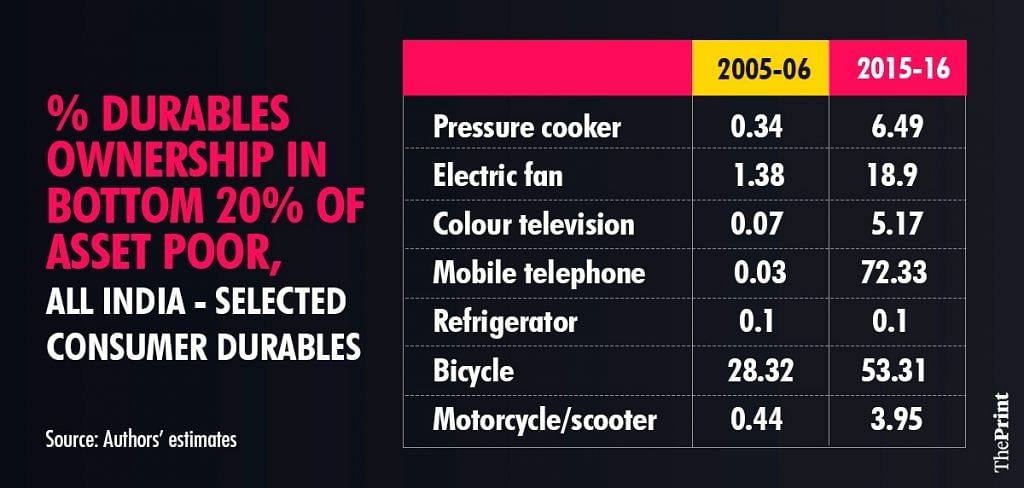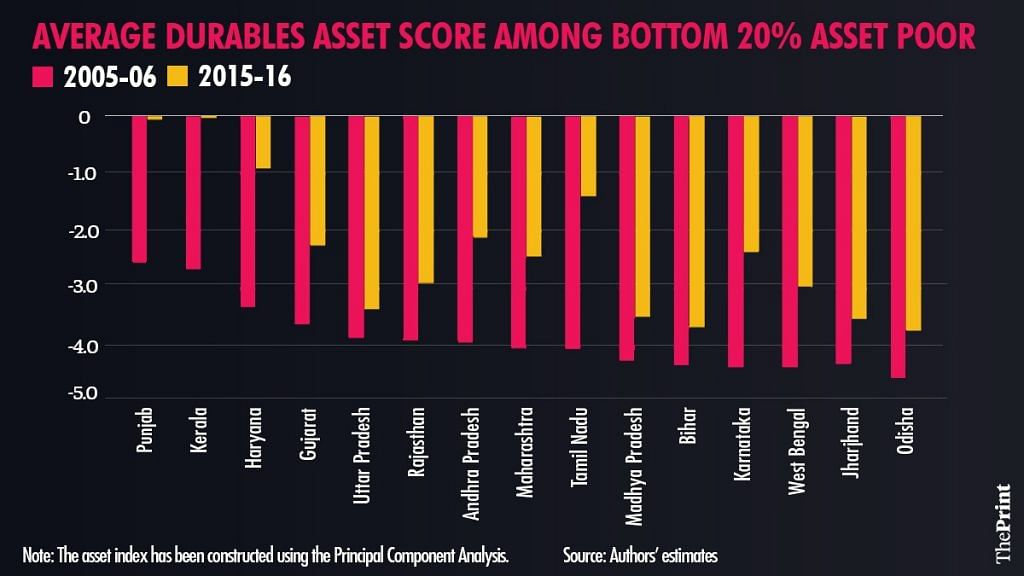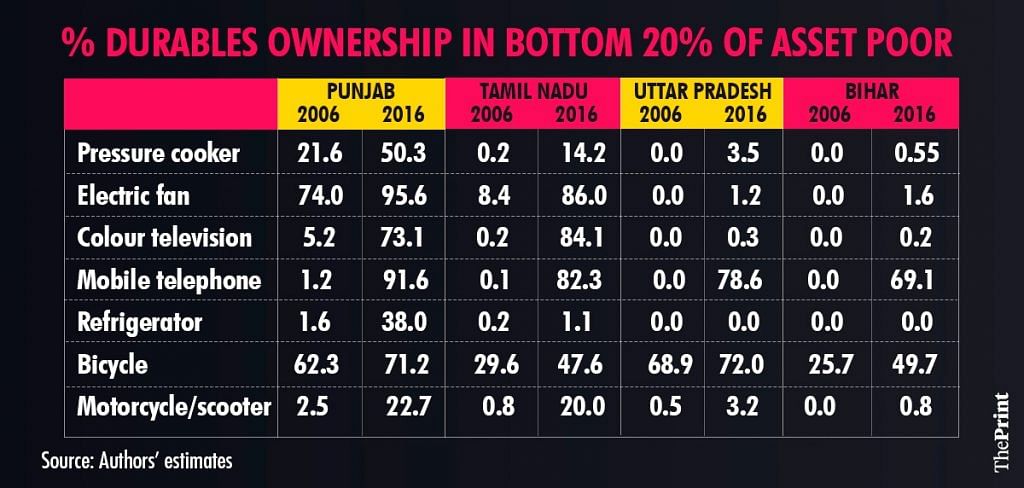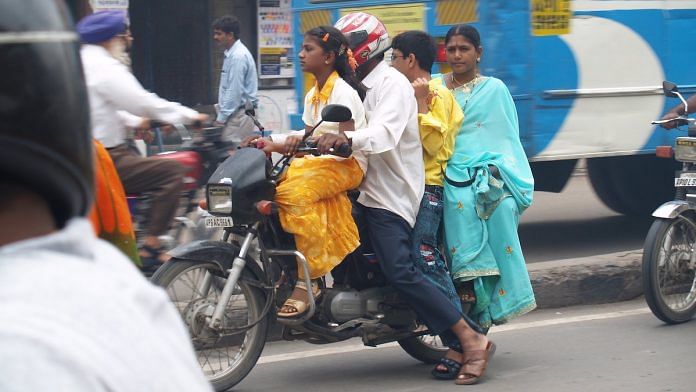Indian households have been acquiring consumer durables at a fast pace in recent years. While the ownership of durable assets is generally associated with the upper-income groups, durables play a pivotal role in bettering the wellbeing of the poor. Durable assets like a mobile phone, motorbike or bicycle can have a multiplier effect on their educational, economic and social status.
How far has the ownership of durable assets improved over time among the lowest 20 per cent of India’s population in terms of the asset poor, and how does the progress differ across key Indian states?
Calculating India’s asset poor
We construct a consumer durable asset index, using individual-level data from the National Family Health Survey (NFHS) for 2005-06 and 2015-16, with a wide array of durables, which are available in both the rounds of the survey. The asset scores range from a high of 4.97 at the upper end to a low of -4.67 at the lower end (suggesting no asset ownership).
We take the bottom 20 per cent of the population as per the asset index score (defined as asset poor) for both years and compare across the years. The lower the negative score, the higher is the possession of assets. At the all-India level, the average durable ownership index value of the asset poor increased to -3.0 in 2015-16 from -4.1 a decade earlier, implying more than a 25 per cent reduction in asset poverty.
The ownership of assets across the number of products increased among the asset poor including bicycle, electric fan, colour television and pressure cooker. The most dramatic increase, however, is in the ownership of mobiles by 2015-16 – more than 7 out of 10 asset poor persons owned a mobile, followed by bicycle (5 out 10). While nearly 4 per cent owned a motorcycle/scooter by 2015-16, the refrigerator ownership was almost nil.
Table 1

Why should the pattern of asset ownership among the poor evolve in this manner of favouring the acquisition of one asset (say, a motorbike) over the other (a say a refrigerator), when the former is much more expensive?
It is likely to be a combination of several inter-related factors – the utility of a refrigerator and pressure cooker depends on food habits, the opportunity cost of women’s work, and the type of fuel used for cooking. But there is also the fact that a refrigerator requires space inside a house along with continuous access to electricity, both of which are not required for a motorbike or a mobile.
Also read: More young urban Indian men appear to be studying longer, not looking for jobs: New research
State-wise look at asset poverty
The differences in the progress of lowering asset poverty across the major states are stark. The durable asset acquisition among the lowest 20 per cent of the asset poor increased sharply over the decade in all four southern Indian states, along with the two prosperous northern states of Punjab and Haryana between 2005-06 and 2015-16 (Fig 1). The other two major prosperous states of Maharashtra and Gujarat were, however, less successful on this front. Among India’s laggard states — Bihar, Madhya Pradesh, Odisha, Jharkhand and Uttar Pradesh — durable asset ownership improved very little.
Figure 1

The contrast between how the lives of the asset poor in Uttar Pradesh and Tamil Nadu have changed over the decade is startling. In 2005-06, the bottom 20 per cent of the asset poor in Uttar Pradesh were slightly better off than their counterparts in Tamil Nadu and many other states. By 2015-16, the asset poor in Tamil Nadu were more than four times better off than the asset poor in Uttar Pradesh. A significant part of increased asset ownership in the bottom 20 per cent in Tamil Nadu is likely to have come from the state policy of free distribution of assets such as a television and a fan.
As a result of the little progress in terms of making a dent in asset poverty, the share of the five laggard states — Uttar Pradesh, Bihar, Jharkhand, Odisha and Madhya Pradesh — in the all-India bottom 20 per cent asset poor increased to 64 per cent in 2015-16 from 48 per cent in 2005-06. The population share of these states in the all-India population, however, continues to be around 37 per cent, suggesting their over-representation in the overall asset poor.
In terms of the ownership rates of durables, while Bihar and Uttar Pradesh have done well in terms of the mobile and bicycle ownership among the bottom 20 per cent of their asset poor, they lag distinctly in terms of the ownership of an electric fan, colour television, pressure cooker and a motorcycle/scooter (Table 2). For example, while in Punjab and Tamil Nadu, more than 20 per cent of asset poor owned a motorbike, less than 1 per cent did so in Bihar. Among the two leading states, which have been shown for a comparative picture, 1 in 3 asset poor persons in Punjab has a refrigerator, while only 1 in 100 of Tamil Nadu’s asset poor owns one.
Table 2

In conclusion, the lives of India’s asset poor have improved over time in terms of the welfare that they and their families can derive by owning consumer durables, but with a wide regional variation. We will explore in detail in the next article whether some of the stark regional differences in durable ownership result from the quality of housing and access to basic services such as electricity.
Vidya Mahambare is Professor of Economics, Great Lakes Institute of Management, Chennai. Sowmya Dhanaraj is Assistant Professor of Economics, Madras School of Economics. Views are personal.
(Edited by Fiza Jha)



